Related Research Articles

Brighton is a seaside resort and one of the two main areas of the city of Brighton and Hove in the county of East Sussex, England. It is located 47 miles (76 km) south of London. Archaeological evidence of settlement in the area dates back to the Bronze Age, Roman and Anglo-Saxon periods. The ancient settlement of "Brighthelmstone" was documented in the Domesday Book (1086). The town's importance grew in the Middle Ages as the Old Town developed, but it languished in the early modern period, affected by foreign attacks, storms, a suffering economy and a declining population. Brighton began to attract more visitors following improved road transport to London and becoming a boarding point for boats travelling to France. The town also developed in popularity as a health resort for sea bathing as a purported cure for illnesses.

Hove is a seaside resort in East Sussex, England. Alongside Brighton, it is one of the two main parts of the city of Brighton and Hove.
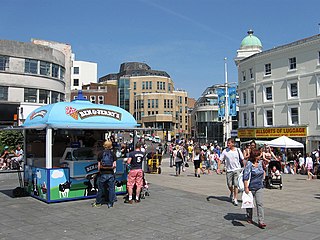
Brighton and Hove is a unitary authority with city status in East Sussex, England. There are multiple villages alongside the seaside resorts of Brighton and Hove in the district. It is administered by Brighton and Hove City Council, which is currently under Labour majority control.

Shoreham-by-Sea is a coastal town and port in the Adur district, in the county of West Sussex, England. In 2011 it had a population of 20,547.
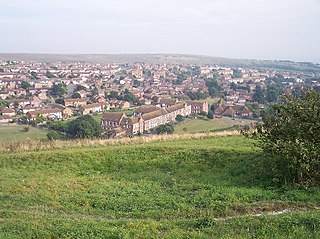
Whitehawk is a suburb in the east of Brighton, England, south of Bevendean and north of Brighton Marina. The area is a large, modern housing estate built in a downland dry valley historically known as Whitehawk Bottom. The estate was originally developed by the local council between 1933 and 1937 and included nearly 1,200 residences. Subsequently, the Swanborough flats were built in 1967, and in the 1970s and 1980s much of the estate was rebuilt by altering the road layouts and increasing the number of houses. Whitehawk is part of the East Brighton ward of Brighton and Hove City Council.

John Steven Bassam, Baron Bassam of Brighton, is a British Labour and Co-operative politician and a member of the House of Lords.

Brighton & Hove Bus and Coach Company Limited, trading as Brighton & Hove, is a bus company operating most bus services in the city of Brighton and Hove in southern England. It is a subsidiary of the Go-Ahead Group.
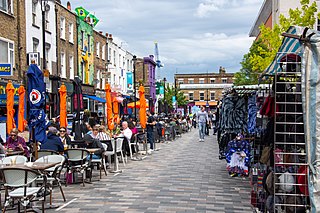
Inverness Street Market is an outdoor street market in Camden, North London. Licences to trade are issued by Camden London Borough Council.

Brighton and Hove Pride is an annual LGBT pride event held in the city of Brighton and Hove, England, organised by Brighton Pride, a community interest company (CIC) which promotes equality and diversity, and advances education to eliminate discrimination against the lesbian, gay, bisexual and trans (LGBT) community.

Hangleton is a suburb of Brighton and Hove, in the ceremonial county of East Sussex, England. The area was developed in the 1930s after it was incorporated into the Borough of Hove, but has ancient origins: its parish church was founded in the 11th century and retains 12th-century fabric; the medieval manor house is Hove's oldest secular building. The village became depopulated in the medieval era and the church fell into ruins, and the population in the isolated hilltop parish only reached 100 in the early 20th century; but rapid 20th-century development resulted in more than 6,000 people living in Hangleton in 1951 and over 9,000 in 1961. By 2013, the population exceeded 14,000.

The history of Brighton is that of an ancient fishing village which emerged as a health resort in the 18th century and grew into one of the largest towns in England by the 20th century.

Patcham is a suburb in the city of Brighton and Hove, in the ceremonial county of East Sussex, England. It is about 3 miles (5 km) north of the city centre. It is bounded by the A27 to the north, Hollingbury to the east and southeast, Withdean to the south and the Brighton Main Line to the west. The A23 passes through the area.
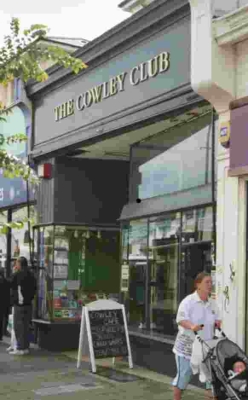
The Cowley Club is a libertarian self-managed social centre in Brighton, England. It opened in 2003, providing resources and meeting spaces for groups and individuals active in areas such as workplace and unemployed struggles, international solidarity, animal liberation, ecological defence, feminist and queer activism and opposing the arms trade. Its political identity is close to anarchism or libertarian socialism. It also houses a vegan community café, a bookshop, and free English lessons for migrants.

Dorothy Stringer School is a secondary school located in Brighton, East Sussex, England. It has over 1,600 pupils and 115 members of staff. There are 64 forms, each with an average of 26 students.
Cardinal Newman Catholic School is an 11–18 voluntary aided comprehensive school located in Hove, East Sussex, England. It is a Catholic mixed comprehensive; established to serve the many parishes that lie on the coastal band between Newhaven and Seaford in the east and Shoreham in the west.

Longhill High School is a co-educational secondary school for 11 to 16 year-olds, which is located in Rottingdean, Brighton and Hove, East Sussex. The school grounds are served by Brighton & Hove bus routes 2, 22, 72, 72A and 76, 76A.

9 Pool Valley is a late 18th-century house and shop in the centre of Brighton, part of the English city of Brighton and Hove. Built as a bakery and shop for a local family, with two floors of living accommodation above, it later passed to another Brighton family who kept up the baking tradition until the mid-20th century. Since then it has had various commercial uses. Described as "one of the most famous surviving early buildings" in Brighton and "a charming relic",[1] the exterior is clad in distinctive black glazed mathematical tiles. English Heritage has listed it at Grade II* for its architectural and historical importance.
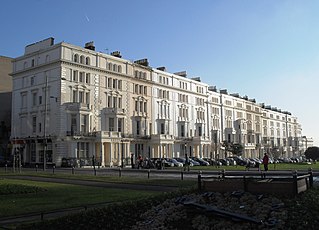
Palmeira Square is a mid-19th-century residential development in Hove, part of the English city and seaside resort of Brighton and Hove. At the southern end it adjoins Adelaide Crescent, another architectural set-piece which leads down to the seafront; large terraced houses occupy its west and east sides, separated by a public garden; and at the north end is one of Hove's main road junctions. This is also called Palmeira Square, and its north side is lined with late 19th-century terraced mansions. Commercial buildings and a church also stand on the main road, which is served by Brighton & Hove bus routes 1, 1A, N1, 2, 5, 5A, 5B, N5, 6, 25, 46, 49, 60, 71, 71A and 96.
Gilbert Murray Simpsonfriba (1869–1954) was a British architect from Brighton who did most of his work in the seaside resort. In 1890 Simpson joined his father Thomas, architect to the Brighton and Preston School Board and the Hove School Board, and helped to design some of the "distinguished group of board schools" for those institutions during the late 19th century. He took over the firm of Thomas Simpson & Son when his father died in 1908, and went on to design several other institutional buildings in Brighton. His elder brother Sir John William Simpson was also an architect.
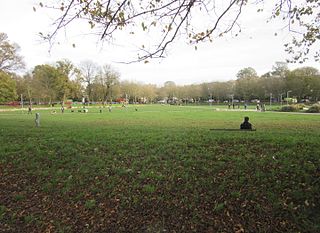
The Level is an urban park in central Brighton, on the south coast of England. The park is a triangle of 8.05 acres (3.26 ha) bounded by Union Road to the north, Richmond Terrace (A270) to the east, and Ditchling Road (A23) to the west. In the past, the land has been used as a cricket ground for the Prince of Wales and as a setting for large-scale dinner parties to commemorate events such as the defeat of Napoleon Bonaparte and the coronation of Queen Victoria.
References
- ↑ "The Guv'nor's spirit lives on". The Argus . January 7, 2003. Archived from the original on September 29, 2007.
- ↑ "WW2 People's War". BBC. BBC Southern Counties Radio. Retrieved 15 May 2019.
- ↑ "Our Patch 7". David Rowland . August 9, 2016. Archived from the original on 2018-06-18. Retrieved 2019-05-15.
- ↑ "The Open Market". OM. Retrieved 14 May 2019.
- ↑ "Names on the buses: 826 Harry Cowley". Buses.co.uk. Brighton & Hove. Archived from the original on September 27, 2007. Retrieved 18 November 2008.